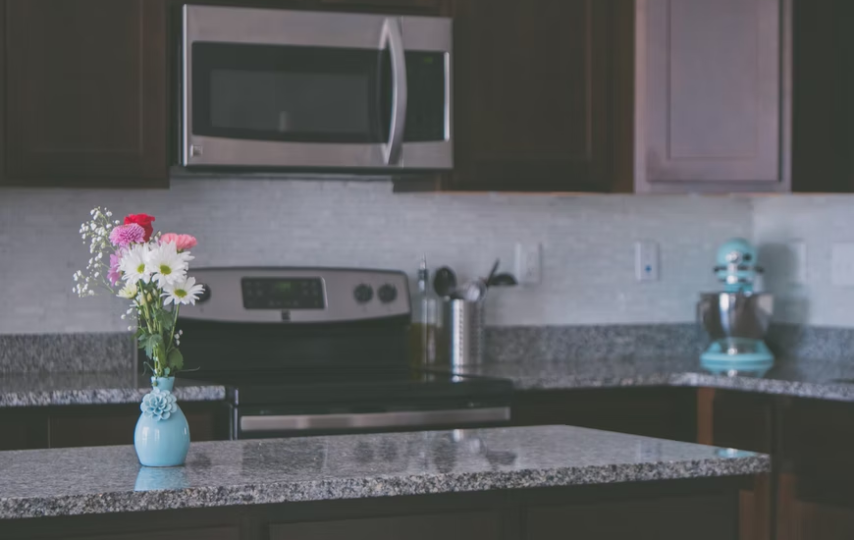One method to beautify your dining area is putting up a granite table. This may be quite costly, but it’s possible to transform a simple dining table into those granite tables sold in furniture shops. You can embark on this table conversion project in the comfort of your home.
You might be wondering about the need to go through the entire process of making your granite table when you can skip it by simply buying one at the store. But making your own would mean you have direct control over how you want it to look. Don’t worry, this article will go through every part and discuss it thoroughly to guide you in the process.
Knowing the Center of Gravity in a Table
Before anything else, you should know where to locate the actual location of weight of a table or the center of gravity. This is essentially important since this is where you determine how the object moves when gravity is acted upon it.
The granite slab is one of your primary materials in this project, and identifying the appropriate size and thickness is significant when searching for your table base. This would mean if you’re going to use a bigger granite slab, you will have to get a bigger table base as well.
However, you don’t have to fret about the possibility of your table base breaking due to the weight of the slab since it can be produced using other materials like cast iron and steel. The center of gravity should still be identified if in cases where the slab is heavier compared to the base, the slab will end up falling.
Another thing to consider to avoid any mishaps is the table base height. The larger the height, the more chances of falling since the center of gravity doesn’t contribute to the object’s stability. Keep in mind that the weight is crucial so if you’re opting to have a tall table, you’ll need a bigger and stronger base.
Planning the design of your table base yourself will allow you more access to the different ways in making it possible than simply selecting between ready-made styles. Various styles have specific benefits once partnered with the granite table tops. Say, vintage table bases are commonly produced with columns and bottoms made of cast iron which adds to the weight of the table and durability.
1. Put towels, newspapers or cardboards on house floors
As a form of protection for your floors, you need to gather cardboard or old towels and rugs and spread them throughout the floors before you start actual work on the tabletop and base. The cardboards are where you put the granite slab that will be used.
2. Eliminate the bottom of the granite to take off the debris and other particles
The following is removing the particles found on the bottom part of the granite slab such as dirt and dust. This is essential to ensure cleanliness and avoid any irregularities in the form. To make sure that the base is rightly placed in the area where you prefer, use a tape measure to check the position and trace it using a pencil.
3. Utilize the caulking gun as adhesive
To connect the base, put silicone in a caulking gun and place lots of adhesive within the insides of the shape you traced with a pencil. Here, you have to press the base downwards into the silicone and remove any access silicone that gets squeezed out under.
4. Search for all the gaps and holes and fill them with silicone
Examine the entire table base and other parts and check for openings so that you can put silicone. Wait for 24 hours first before flipping the table to its top. Right after linking the table base to the top, the silicone should dry first.
5. Constructing a table frame
You can build one in cases where no table base has met your standards. Using wood, just build a table frame based on the measurements of the table top (the computation of the frame dimensions will be detailed in the next step). It doesn’t require too many materials and other processes since you’ll only be cutting pieces of wood and connecting them. There are video tutorials on Youtube that show you how to make one in pretty easy methods.
6. Measuring the dimensions of the granite slab
Get a measuring tape to measure the entire granite slab and subtract four inches from each measurement to get the dimensions of the table frame that you’ll be making. In producing the support piece of your tale, you need to prepare four pieces of 2 x 4 (5.08 x 10.16 cm) hardwood where the two pieces are for the length while the remaining are for the width.
7. Layout the wood pieces into a rectangular shape
The four wooden pieces should be laid out into a rectangular formation where the shorter pieces are placed at the ends of the longer ones. These will be connected using 4-inch (10.16 cm) wood screws and will be steered through the long boards into the width boards to connect the pieces.
8. Connect the table legs
For the table legs, you need to cut down four pieces of 4 x 4-inch (10.16 x 10.16 cm) hardwood posts according to the table height. After, lay down a cloth on the floor and place the table frame. Place the table legs on each side and press them to the edges.
To attach the legs to the frame itself, drill four holes on the outer part of the edges of each table corner. Using a screwdriver, attach 5-inch (12.7 cm) carriage bolts until the head is shown against the frame. To keep the table secured, add 2-inch (5.08 cm) wooden screws on the inside edges of the table legs.
9. Cut down fitted plywood to balance the granite
Just to ensure that the granite is stabilized and secured, you’ll have to prepare a piece of fitted plywood attached to the table base. Cut down ½ inch (1.27 cm) thick piece of plywood based on the exact measurements of the table base, turn over the table base up, and lay the wood on the top. Place the nails into the plywood to attach them to the bases.
10. Putting stain or paint on the bases and frame
At this point, the table you’ve been working on is about to be finished since this is where the bases have become yours. You may opt to paint or stain depending on how you want it to appear.
The color of the granite is also something to remember when selecting the color of the frame and you’ll have to keep the stain or paint dry before doing anything with the table parts.
11. Placing the table in its actual position and attaching the slab to the top
You can now position the table in its appropriate stance and put the slab on the top. You might want assistance from a friend or neighbor in transferring the slab on the topmost part of the base and frame. Make sure that the slab overhangs by 2-inches (5.08 cm) on each corner of the frame. You may opt to stick the top and bottom parts together with an adhesive or just leave it be.
Conclusion
Be reminded that the steps above are simply general guidelines in forming table bases and the right construction will depend on the several factors and considerations that must be accounted for. What the others have indicated that has worked well for them may not apply to your case. One illustration may be the type of granite slab used could be effective for them while for you, it is not. Or possibly you may be working on an uneven floor which may affect the bases and slab.
You may want to read more about effectively constructing your granite table. Just click to learn more about granite table making.
Also Visit: Clarifies Russia belaruscrawleycoindesk













